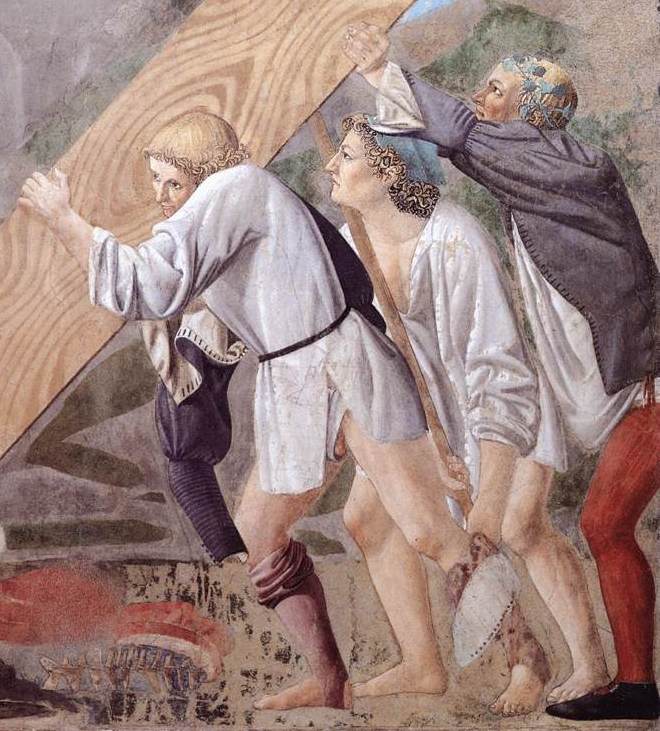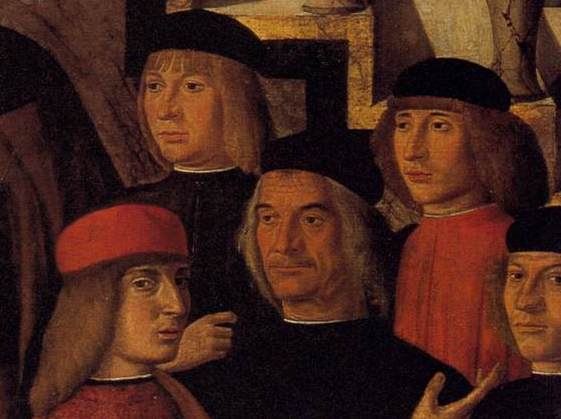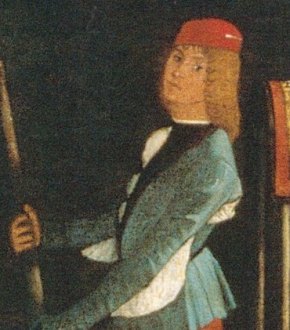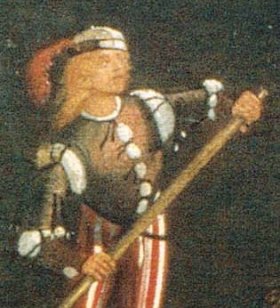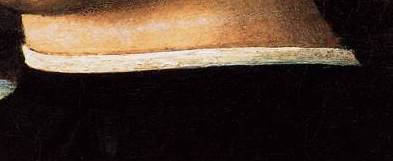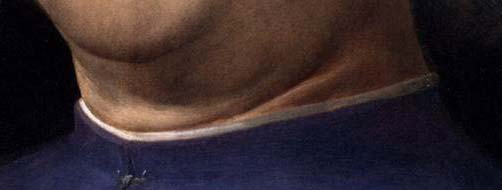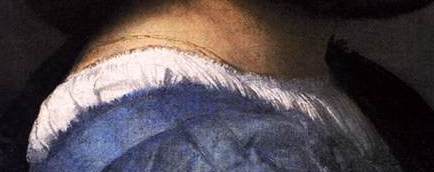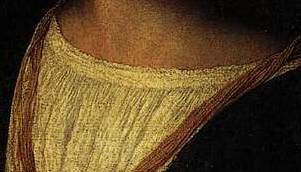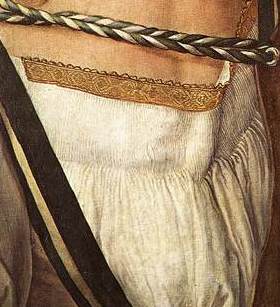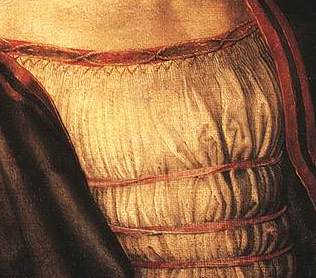No matter how fine the exterior garment, something easily washable must be worn close to the skin. At the end of the fifteenth century in Venice this was a camisa, or linen shirt, which can be seen clearly puffed through the many openings in the zupon.[1]
Reconstructing the shirt has been my greatest conundrum. I made certain assumptions based on my knowledge of shirts from other time periods: it is most likely linen, for durability and comfort, and it is most likely constructed from a fairly geometric cuts of fabric, not tailored as the outer garments are (see lengthier discussion in Birbari's Dress in Italian Painting 1460-1500).[3] Beyond that, I have been a font of questions, many of which I have not answered to my satisfaction.
Basic Geometric Shirt
Here is an image (not from Venice) that captures my concept of a basic, traditional shirt:
It can be reconstructed with two rectangles for the body, each side seam left open from the waist down for freer movement; two square gussets under each arm; rectangular sleeves of approximately arm length sewn onto the body; and a front slit so that the shirt slides easily over the head. This shirt could gather into a collar of some sort, and the wrist could gather to a cuff, but this would alter the basic construction of this shirt very little. I have sewn shirts much like these for my husband and sons to wear when doing 18th century reenacting;[4] this style has been popular for centuries.
This style also, I believe, cannot possibly be what the gondoliers, young men, and (by extrapolation from these two) togati are wearing in Venice in 1500.
Observations about the Camisa
From examining the gondoliers, I can see that the sleeves of the shirt must be extra-long, so that they can puff out at the elbow, wrist, or anywhere else the zupon is left open along the arm. I can also see that it must be extra wide in front, at least in the center of the body, so that it can puff out the front of the zupon; I also suspect that the full shirt contributes to the D-shaped fashionable rounded profile. It must not be so bulky in the back as to mar the tight lines of the fitted zupon. It must be long enough in back to remain tucked in and gather in full folds between the calze and zupon, even when the points are left untied for strenuous work, as gondoliers and soldiers often do.
From examining both portraits and group scenes, I know that the camisa must have a marginally wider standing collar than the zupon and toga that are worn over it. On gondoliers wearing ziponi without collars, the same narrow line of white is visible, so they must have a shirt with a minimal collar.
Not a Venetian Shirt
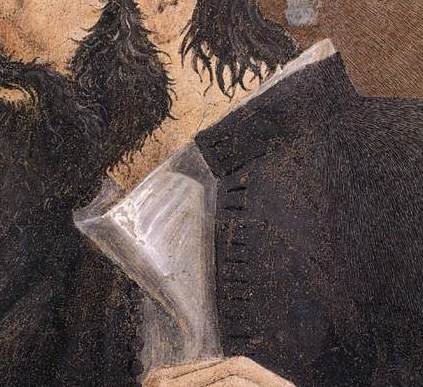 But how is the Venetian shirt cut and shaped? I know that one possible Italian Renaissance shirt, which has been reconstructed by others,[5],[6] is loose enough to pull over the head. When the farsetto (outer garment) is fastened, the collar folds back on itself, becoming a standing collar that is cut in one with the shirt. The following images are NOT from Venice.
But how is the Venetian shirt cut and shaped? I know that one possible Italian Renaissance shirt, which has been reconstructed by others,[5],[6] is loose enough to pull over the head. When the farsetto (outer garment) is fastened, the collar folds back on itself, becoming a standing collar that is cut in one with the shirt. The following images are NOT from Venice.
(right) Loose enough to pull over the head.
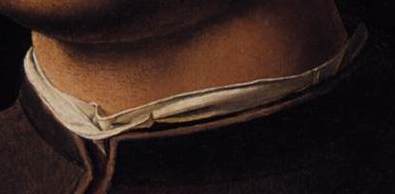 Very clearly folds back upon itself.
Very clearly folds back upon itself.
 Although this painting and the following are more subtle, the diagonal line near the center front has been interpreted as a fold in a loose shirt, like the first two images above.
Although this painting and the following are more subtle, the diagonal line near the center front has been interpreted as a fold in a loose shirt, like the first two images above.
The Venetian Collar: No Folds or Lines
 I do not think that this is the way the Venetian shirts were constructed, because in artworks with similar levels of realism and detail, I do not see a fold line in the band of white visible in Venetian portraits. These are all portraits of Venetian men:
I do not think that this is the way the Venetian shirts were constructed, because in artworks with similar levels of realism and detail, I do not see a fold line in the band of white visible in Venetian portraits. These are all portraits of Venetian men:
Not only do I not see any folds, I do not see a line in the center or on the shoulder, indicating that two halves of a band collar are meeting or overlapping at this place. I see no evidence of closure at all, nor evidence that the shirt is loose enough to pull over the head; based on these images, the shirt must close either on the right shoulder, further back on the left shoulder than shown in these portraits, or in the back.
Fullness in the Sleeves and Front
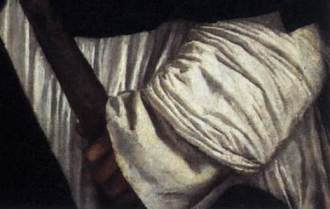 Even if I took my concept of a "basic shirt", attached a standing collar, and moved the front slit to the back of the neck, it would not have enough fullness. I would also have to lengthen the sleeves, like this (right):
Even if I took my concept of a "basic shirt", attached a standing collar, and moved the front slit to the back of the neck, it would not have enough fullness. I would also have to lengthen the sleeves, like this (right):
 I would also have to add a lot of fullness to the front center, without adding bulk to the back. This is not too difficult to do if a shirt is loose and pulls over the head, like this young Venetian's (left). However, it seems clear that the togati, and many young men and gondoliers, are wearing a shirt with a collar. Titian paints two sitters with full, gathered shirts (below), but both are fitted to collars loose enough to go over the head, and therefore cannot be quite the style I am trying to recreate.
I would also have to add a lot of fullness to the front center, without adding bulk to the back. This is not too difficult to do if a shirt is loose and pulls over the head, like this young Venetian's (left). However, it seems clear that the togati, and many young men and gondoliers, are wearing a shirt with a collar. Titian paints two sitters with full, gathered shirts (below), but both are fitted to collars loose enough to go over the head, and therefore cannot be quite the style I am trying to recreate.
This style's fullness and the tiny gathers appear similar to the German fashions worn by Durer (below).
Such voluminous fashion attracted the attention of the Venetian governing body, because "On 8 January 1506, the publication of the Maior Consiglio, says Priuli, was to apply to every young man of the city, whether working-class or patrician, who had adopted the evil and damnable custom of acquiring...shirts taking six braza of linen each to make (1 braza = c. 1 yd)."[7] Apparently the young men took little notice of this censure:
"On 8 May 1512, on an application from Nicolò Grimani, the Senate gave its full attention once more to the subject of dress. ...The description of the styles forbidden to [young men] was remarkably similar to that of those condemned in 1506 and 1509. Shirts – camise – in the French style were not to be gathered up at the throat a la francese.... The sitter in this painting [by Titian, often thought to be of Ariosto, see above in blue] also wears a shirt gathered up in what was probably thought to be the 'French' fashion. This has also been regarded as a self portrait. If the painting does represent a Venetian, a problem is posed by the presence of a well-trimmed beard. From his dress the sitter is certainly not wearing mourning."[8]
So the young men, at least, and probably others, were wearing shirts using perhaps as much as 6 yards of linen. I do not know how wide the linen available in Venice in the year 1500 might have been, but 6 yards of even narrow (36 inch) fabric seems to me to be a great deal for a shirt.
How, exactly, is all this linen to be squeezed into a shirt? One answer, which I hope to explore in greater depth in the future, is the use of pleatwork, more commonly known today as smocking or shirring. Baroness Rainillt de Bello Marisco diagrams several possible ways to cut and assemble a pleated man's shirt, and I have not had time since discovering this article to reconstruct her ideas, so I cannot vouch for their effectiveness in recreating the Venetian look.
Reconstructing the Camisa
My first attempt to reconstruct a shirt was a fairly blind stab at some way to cause puffs of fabric to poof from the front of the zupon and from the shoulder and elbow region. I put the closure at the side of the neck, leaving open part of the shoulder seam, because that seemed easy and more logical than a front slit. I made the front panel wider than the back, and made the arms ridiculously long. I didn't know how much fabric it would take to puff at the shoulder and elbow, and figured that for the first mock-up, it would be much easier to cut than to add on length.
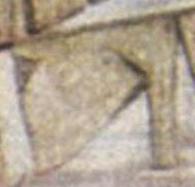 After constructing this concept shirt (which I never completely finished, as I mostly needed it to help me fit and tweak the design details on the zupon I was making), I spent some time perusing this image, which is but a tiny detail in the back of my favorite Carpaccio scene. Several items of white clothing are hung out on poles from the upper stories of buildings, and this one I judged to be a man's shirt. When studying this shirt, I assumed that I was seeing half the shirt, and that it was folded almost exactly in half, front side down, over the pole.
After constructing this concept shirt (which I never completely finished, as I mostly needed it to help me fit and tweak the design details on the zupon I was making), I spent some time perusing this image, which is but a tiny detail in the back of my favorite Carpaccio scene. Several items of white clothing are hung out on poles from the upper stories of buildings, and this one I judged to be a man's shirt. When studying this shirt, I assumed that I was seeing half the shirt, and that it was folded almost exactly in half, front side down, over the pole.
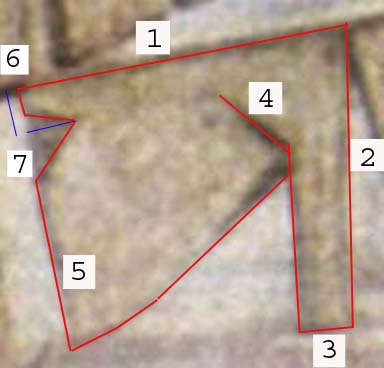 I magnified it greatly, marked the edges of the garment that I could see clearly, and measured each of seven lengths, listed here.
I magnified it greatly, marked the edges of the garment that I could see clearly, and measured each of seven lengths, listed here.
1. length of the shirt from shoulder to mid-thigh
2. half the shoulder width plus the arm length
3. half the arm circumference at the wrist
4. the diagonal of the folded square that forms the gusset
5. ignoring the triangle that marks the open portion of the side seam, and measuring from the pole (also line 1) to the bottom corner of the shirt, this should be rougly one quarter of the circumference of the body of the shirt
6. (blue line) half the width of the back panel of the shirt
7.
(blue line) length of the slit at the side seam
I also note that the slit at the side (7) and the end of the gusset (4) seem to end approximately the same distance from the top of the shirt as it drapes over the pole, leading me to believe that the back is a rectangle with the same width throughout the entire panel.

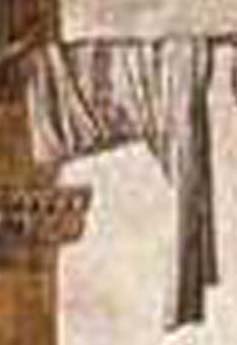 Since the laundry image gave me so much to think about, I looked for additional similar images, and found this one, a scene also painted into the background of the Miracle of the True cross series. Unfortunately, I cannot find as high a resolution image of this as I can of the Carpaccio laundry image, and also, this shirt is in the process of being hung out, and therefore is wrinkled and even harder to examine.
Since the laundry image gave me so much to think about, I looked for additional similar images, and found this one, a scene also painted into the background of the Miracle of the True cross series. Unfortunately, I cannot find as high a resolution image of this as I can of the Carpaccio laundry image, and also, this shirt is in the process of being hung out, and therefore is wrinkled and even harder to examine.
When I study this magnified image, I see:
- evidence of a standing collar
- the laundry is not quite balanced yet, and based on the sleeve in back, more of the shirt is hanging toward the viewer than away
- the sleeves are long and the gusset is large
- as with the first laundry image, the bottom of the shirt hangs further down than the part near the arms, leading me to conclude that the front is a panel that is gathered near the top of the shirt
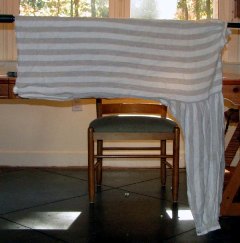
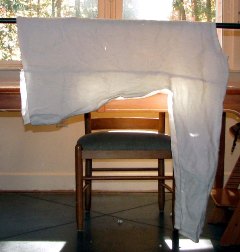
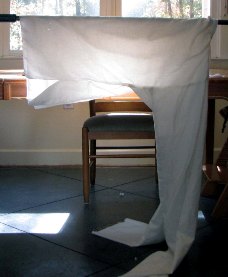
To test my theory about how these shirts were hung out to dry, I took shirts out of my husband's existing wardrobe and draped them over a pole to photograph. The first, striped shirt (an 18th century reproduction) has equal width panels in front and back; not at all right.
The second has equal width panels in front an back, but angled side gores to add fullness. Although the angle of the line at the bottom of the shirt looks more like the painting above, it lacks a side slit and a gusset, and does not seem to me to be a reasonable pattern for approximating the Venetian shirt.
The third image is my first attempt at Venetian mock-up. Draping it in this way, I see that I have the idea about the side slit right (notice how the weight of the fabric folds the front panel under at the slit; I think I see this same effect in the painting above) but that my back panel is too wide and my front too narrow. My sleeves are also too long and my gusset too small.
Returning to the marked-up painting, I then put these seven measurements into a spreadsheet and fiddled with the numbers, trying to come up with a plausible shirt. I began by choosing the shirt length, as that seemed to be the least questionable feature of the painted shirt. For my husband, a generously long shirt would be about 1 yard from shoulder to hem. Using that as a base measurement and calculating all other measurements in relation to that one results in some crazy numbers (all measurements in inches, no seam allowance included):
| Calculated based on the painted shirt | Measured on my first test shirt | Measured on my husband | Measured on my second test shirt | |
| back panel length | 36 | 33 | 36 | 36 |
| armspan, cuff to cuff | 66 | 112 | 60 | 104 |
| back width | 12 | 26 | 14 | 14 |
| front panel width | 100 | 43 | 102 | |
| gusset side | 7 | 3.5 | 8 | |
| depth of side slit | 6 | 5.5 | 6 | |
| sleeve panel width | 13 | 23 | 19 |
It seems as if the only thing I got right the first time was the depth of the slit on the side seam!
Before discarding my first mock-up, I tried narrowing and shortening the sleeves by degrees, trying to find out how much fabric I needed to imitate the painted poofs of the gondoliers. Here is the result of my second mock up:
Current and Future Work
As I said before, this shirt has been the most puzzling garment to reconstruct. Because I am uncertain of my theories, because pleatwork embroidery is a new technique for me (I have only ever attempted a single sampler in a class at Pennsic), and because I feel certain there are significant references that I am missing (such as finding proof of shirt with a standing collar and back or side closure), I have not yet attempted a "finished product" shirt, only quick mock-ups.
References
1. Stella Mary Newton, The Dress of the Venetians, 1495-1525 (Aldershot, England: Scolar Press, 1988), 33.
2. Jacqueline Herald, Renaissance Dress in Italy 1400-1500 (London: Bell & Hyman; Atlantic Highlands, N.J.: Humanities Press, 1981), 224.
4. Linda Baumgarten and John Watson with Florine Carr, Costume Close-up: Clothing Construction and Pattern 1750-1790 (New York: Quite Specific Media Group Ltd., 1999), 105-108.
5. Lorenzo Petrucci, An Overview of Men’s Clothing in Northern Italy c. 1420 - 1480, http://www.houseofpung.net/sca/15c_mens_italian.pdf (accessed March 19, 2011), 2.
6. Ciar inghean ui Fhothaidh, 1488 Italian Male Garb: Shirt, http://www.angelfire.com/zine/kiarapanther/garb/shirt.html (accessed March 19, 2011).
